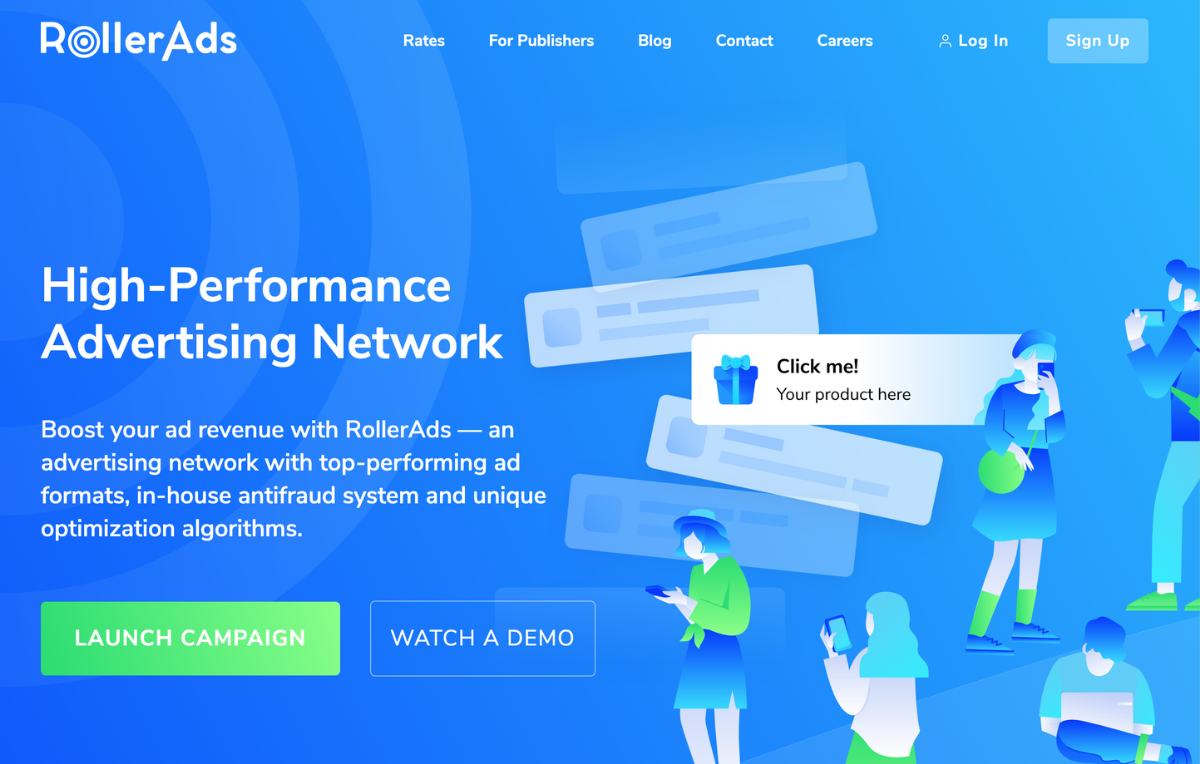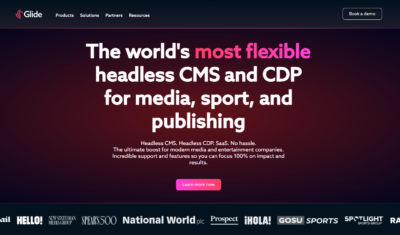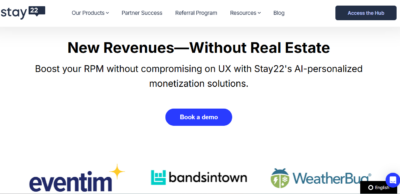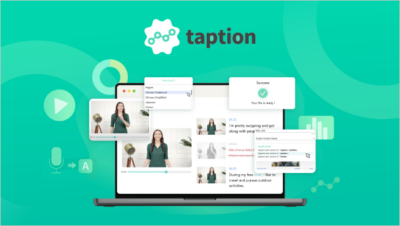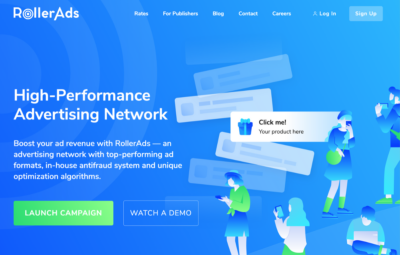Displaying relevant ads to users without disrupting the user experience (UX) has always been a challenging tightrope for publishers to walk.
Showing too many ads or ads that are too prominent can disrupt a user’s browsing experience, while also impacting page load times. On the other hand, displaying too few ads, or ads that users barely notice can impact revenue negatively.
RollerAds is an ad network that helps publishers negotiate this tricky path by leveraging push notifications to generate extra revenue on top of what publishers already make from other ad formats such as banner and video ads. It does this without impacting the user’s browsing experience, while promising better clickthrough rates (CTR) and conversion rates.
Join us as we weigh in on RollerAds’ pros and cons and try to understand how well it delivers on its promises.
What Are Push Notifications?
Push notifications are messages that users receive on their desktop or mobile in the form of alerts or reminders urging them to take an action, such as visiting a third-party website.
These notifications are only sent to users who have subscribed or opted-in to receive them, thereby increasing their relevance, resulting in higher user engagement rates and eventually, better revenue for publishers.
Once users give their consent and enable push notifications, publishers can send push notifications which the user can view from the device lock screen even if they are not currently browsing the publisher’s website.
Industry-wide opt-in rates for push notifications are quite impressive, with some estimates pegging them at 81% for users on Android devices and 51% for iOS users.
This format was first introduced by Apple in 2009 as the Apple Push Notification service (APN). It soon gained widespread acceptance in the digital marketing industry due to its low cost, nearly 100% delivery rate, and high engagement rate.
What Is RollerAds?
RollerAds is an advertising network specializing in three high-performing ad formats:
- Push Ads: These are instant message-type ads that deliver promotional announcements and sales offers directly to peoples’ mobile devices or web browsers.
- In-page Push Ads: Also known as IPP, these are web notifications that appear on a user’s browser only when they visit a website.
- OnClick Ads: Also known as popunder ads, these are a non-intrusive ad format that open up in a new browser window behind or ‘under’ the main browser window.
Both push notifications and IPP ads have especially high click through rates (CTRs) compared to traditional formats such as banner ads, email ads, and videos. According to information provided by RollerAds, push notifications have CTRs of up to 8%, compared to mere 1-2% for email ads, making them over four times as effective as the latter.
Push notifications are also virtually immune to ad blockers, further increasing their relevance.
The great thing about RollerAds’ push notification ads is that publishers can use them along with other conventional ad formats such as banner ads.
Another advantage of push notifications for publishers is that they can use them to not just monetize their content, but also to communicate with their audience and grow their brand.
To this end, they can use in-house push notifications, which send updates about a publisher’s own content, product, or service, instead of redirecting them to a third-party.
In this case, push notifications work like an email newsletter or an SMS alert, allowing publishers to grow their subscriber base rather than promoting a third-party product or service.
RollerAds also has its own affiliate network, CPARoll for affiliate publishers to work with.
Launched in 2019 from Delaware, United States, RollerAds is a fairly new entrant in the crowded ad network market. However, its focus on a few high-performing ad formats has allowed it to carve a niche in this competitive segment.
As of April 2024, it claims to have more than 10,000 publishers and 8,000 advertisers on its platform, generating more than 3 billion impressions and 3 million clicks every day.
RollerAds’ Pricing and Features
RollerAds works on a cost-per-click (CPC) model for push notification ads and cost-per-mille (CPM) model for its OnClick or popunder ads. How much of this revenue is shared with the publisher is not stated on the website. Publishers need to get in touch with RollerAds to get an estimate of their potential earnings.
Some of RollerAds’ prominent features include:
In-built Fraud Detection
Since RollerAds’ notifications are delivered directly to the user’s screen, there is little chance of ad bots inflating the impression count. For this same reason, push notifications also cannot be blocked by ad blockers.
WordPress Plugin for Easy Setup
RollerAds is easy to set up, even for publishers with no coding knowledge. For WordPress publishers, they’ve made things even easier with a WordPress plugin that takes care of all the hassle of installing and running RollerAds.
Easy Subscriber Migration
For publishers already working with another push notifications ad network who wish to migrate to RollerAds, the company offers fast and easy migration supported by their technical staff.
Publishers simply need to identify the Javascript (.js) files used by their previous ad network, and RollerAds provides them with new custom .js files to replace these. The transition is completed within 3-7 days with minimal loss of subscriber base.
Custom Subscription Window and Content Locker
RollerAds provides publishers with a subscription window template to which they can add their own text for onboarding new subscribers. The window comes with a content locker, which locks the notification on the user’s screen until the user performs a predefined action such as opting-in or opting-out of the notification service.

RollerAds Publisher Requirements
Unlike several other ad networks, RollerAds has fairly relaxed publisher requirements. It does not have any strict minimum traffic or revenue thresholds. As long as a website receives some genuine traffic, it is eligible to work with RollerAds.
Here are RollerAds’ publisher requirements in detail:
- No adult sites or sites promoting legally forbidden content such as alcohol, cigarettes, or drugs
- Sites with no traffic
- Sites built on Blogspot, though WordPress sites are accepted
- Sites of which the user is unable to confirm ownership
The reason RollerAds does not work with Blogspot websites is because of the technical difficulty involved in implementing push notifications in Blogspot.
All submitted websites are moderated by the RollerAds team before they are approved.
Getting Started With RollerAds’ Dashboard
RollerAds has separate dashboards for publishers and advertisers, each with its own set of features.
When publishers first log in, they see a welcome screen that looks like this.

To begin using RollerAds, publishers need to add their website to the platform. This can be done by clicking on the Sites tab in the menu on the left.

Next, click on the ‘Add new site’ button to add a website to RollerAds.
A helpful RollerAds feature are the popup messages from Pierre Bertin, the Business Development Manager at RollerAds that guide new users about the next steps they need to follow.

Next, publishers need to add their site’s URL and confirm that their website meets RollerAds’ requirements.

Once this is done, publishers need to click on the “Get verification file” button, and save the verification file to the root folder of their website. This can be using any FTP client or by contacting their hosting provider.

Once verified, the publisher’s website is submitted for moderation. The moderation process is typically completed within 24-48 hours.
Next Steps With the Dashboard
Once their site has been approved, publishers can start sending out push notifications to their subscribers, and monitor results through the dashboard.
The Statistics tab on the left menu is where publishers can track metrics such as the number of subscribers, people who unsubscribed, the number of impressions, CPM, and profit.
These metrics can further be filtered according to criteria such as time period, geolocation, platform (Android, iOS, Windows, etc.), and ad format.
All statistics are displayed with a 4 hour time lag, although RollerAds suggests that publishers wait up to 12-24 hours to get the most accurate results.

The Earnings tab gives publishers an overview of their total earnings within a specified period.
Payouts

Payouts is where publishers can set their preferred payment method, and also see their payment history. They can also set their payout preferences to auto or manual withdrawal.
Publishers must have accumulated at least $50 in earnings to be eligible to withdraw their earnings. This is a fairly relaxed payment threshold compared to several other ad networks. For instance, Google AdSense has a minimum payment threshold of $100 for publishers in the United States.
A great RollerAds feature is its support for a wide number and type of payment methods. These include not just the most common payment methods such as wire transfer, PayPal, and Payoneer, but also lesser known payment services such as Capitalist, Paxum, and Webmoney.
RollerAds also supports payments using cryptocurrency, with support for Ethereum and Tether. We haven’t encountered many ad networks that offer support for such a wide variety of payment methods.
Referrals
RollerAds runs a referral program that allows publishers to invite others to the platform through a referral link. Once they’re approved, publishers receive 5% of the earnings of the publisher they invited to the platform at the end of each month.

An interesting feature of this referral program is that there is no mandatory requirement for publishers to themselves be running RollerAds on their websites. They can simply register as a publisher, refer other publishers using the referral code in their publisher dashboard, and start earning commissions, without even adding their own website to the platform.
Help and Support
RollerAds provides email, Skype, and Telegram-based support to publishers. Response times are usually less than 24 hours.
There is also a library of online help and support articles that users can refer to. The platform, however, does not provide phone-based support.
However, given that this is a simple, easy-to-use, and no-frills platform, most publisher issues are easily resolved over email or by going through the online help resources.
RollerAds in Review
Now that we’ve seen how RollerAds works, we’ve found that there’s a lot to love about the platform. We also feel that there are a couple of areas where RollerAds could deliver a little more to publishers.
What We Love About RollerAds
- A simple, easy-to-use interface
- Quick setup and website moderation process
- Relaxed eligibility requirements
- Support for a wide variety of payment methods
- Low payment withdrawal thresholds
- Referral program for additional earnings
Where There’s Room for Improvement
- Could consider introducing phone-based support
- Could do with a little more pricing transparency for potential customers
All in all, we feel RollerAds is a reliable ad network that delivers exactly what it promises — high-performing ad formats without the complex optimization and management requirements of other ad networks.
Once set up, it pretty much works on autopilot, with very little required from the publisher’s side. The high conversion rates of desktop and mobile push notifications along with the added monetization opportunities the platform offers through its referral program allow publishers the potential to multiply their ad revenue.
The fact that publishers can run these ads without giving up on their existing ad network makes it certainly worth a try.
In the final analysis, we feel confident recommending RollerAds to publishers of all sizes interested in increasing their ad revenue through high-performing ad formats.



